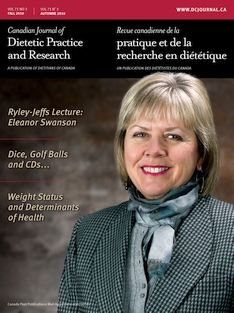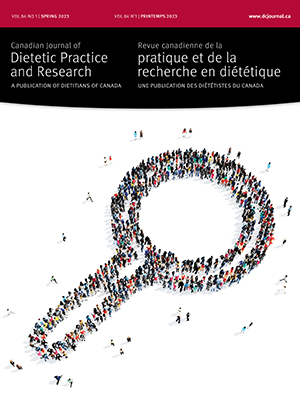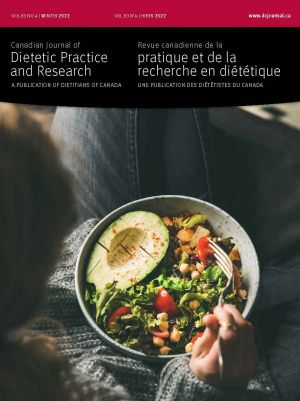Volume 71 • Number 3 • September 2010
Chair’s Message
Editor’s Message
Research
Purpose: Because of the tremendous increase in overweight and obesity in Canadian children and youth in recent decades, we examined associations among health determinants, healthy living characteristics, and overweight and obesity in Manitoba children and youth. Methods: Using descriptive statistics and logistic regression, we identified factors associated with measured overweight and obesity in a sample of 1651 Manitoba children and youth aged two to 17 years from the 2004 Canadian Community Health Survey 2.2—Nutrition. Results: Thirty-one percent of the children and youth were overweight or obese. Males aged 12 to 17 or from foodinsecure homes were more likely to be overweight or obese than were younger males or males from food-secure households. Females from households with higher parental education were less likely to be overweight or obese than were those from households with lower parental education. Female youth who were sedentary for at least three hours daily were more likely to be overweight or obese than were less sedentary female youth. A trend toward significance with overweight or obesity in youth was noted with levels of daily fruit and vegetable consumption and regular physical activity. Conclusions: Overweight and obesity in Manitoba children and youth are associated with socio-economic and demographic characteristics, and with food and activity behaviours. These findings can inform health and nutrition policy and practice by indicating health inequities that require particular attention.
Purpose: Differences in body image and dieting concerns were assessed in preadolescent boys and girls across the body mass index (BMI) spectrum. The hypothesis was that girls would express more concern with body size, report more dieting, and receive more advice than boys. Methods: In this cross-sectional descriptive study, ageappropriate figure drawings, the Children's Eating Attitudes Test (ChEAT), the Restraint Scale, and the Body Esteem Scale were administered to participants in the Study of Asthma, Genes and Environment, Manitoba. Responses were compared between genders and correlated with BMI percentiles. Results: A total of 565 10- and 11-year-old children (321 boys) completed questionnaires. Overall, 39% of participants wanted to be thinner, and no significant gender differences based on weight were found. However, the use of figure drawings indicated that girls desired greater changes in body size (p=0.006). Girls had higher Restraint Scale scores (p=0.003), but no statistically significant differences were found in self-reported dieting, ChEAT, or Body Esteem Scale scores. Approximately 25% of children reported receiving frequent weight-related advice. Girls did not report this more often than did boys. Children in the lowest BMI percentile desired the greatest change in body shape and had the highest Restraint Scale scores. Conclusions: Key gender differences underline the importance of understanding children's attitudes toward body image, weight, and dieting.
Purpose: Food consumption patterns of an Innu community were described and the benefits of traditional food (TF) were investigated in relation to body mass index (BMI). Methods: A cross-sectional study was conducted using food frequency and 24-hour recall questionnaires to evaluate consumption patterns (n=118) and to assess energy and nutrient intakes from TF and store-bought food (SBF) (n=161). Body mass index was calculated with a sub-sample of 45 participants. Results: Mean yearly TF meal consumption was significantly related to age (p=0.05). Participants reporting high TF and low SBF consumption presented with a normal body weight (BMI=24.1) at the lower quartile and a slightly overweight status (BMI=25.8) at the median. Mean values for protein and carbohydrate intake were higher than the Dietary Reference Intakes, whereas dietary fibre intake was below these guidelines for both genders. Store-bought food provided higher levels of energy and nutrients, except for protein. Conclusions: Although Innu consume high amounts of TF and SBF, a lack of some essential nutrients was observed. Because TF intake was related to a tendency toward a lower BMI, a combined, targeted diet could be proposed. Health services could reinforce the importance of TF consumption and promote traditional dietary practices that offer advantages at many levels.
Purpose: Factors underlying food-purchasing decisions were examined among a sample of low-income Toronto families. Methods: A cross-sectional survey was completed among 485 families residing in high-poverty Toronto neighbourhoods. Food-security status was assessed using the Household Food Security Survey Module. Open-ended questions were included to examine respondents’ food selection and management practices and their purchasing decisions for six indicator foods. Logistic regression was used to examine associations between factors influencing food-purchasing decisions, perceived food adequacy, and severity of food insecurity. Results: Twenty-two percent of families had been severely food insecure in the past 30 days. Respondents engaged in thrifty food shopping practices, such as frequenting discount supermarkets and budgeting carefully. Price was the most salient factor influencing food-purchasing decisions; the likelihood that families would report this factor increased with deteriorating food security. Preference, quality, and health considerations also guided food-purchasing decisions, but generally to a lesser extent as food insecurity increased. Household food supplies reflected constraints on food purchasing, and they diminished with increasing food insecurity. Conclusions: Despite their resourcefulness, low-income families struggle to feed their families. Dietitians have an important role to play as advocates for adequate income supports to promote food security and nutritional health.
Perspectives in Practice
Two education interventions involving personalized messages after nutrition screening in older adults were compared to determine changes in nutrition knowledge and risk behaviour. Of 150 older adults randomly selected from a local seniors’ centre, 61 completed baseline screening and a demographic and nutrition knowledge questionnaire and were randomized to one of two groups. Group A received personalized letters plus an educational booklet, and Group B received personalized letters only. All materials were sent through the mail. Forty-four participants completed post-test questionnaires to determine change in knowledge and risk behaviour. Both groups had reduced nutrition risk scores and increased knowledge scores at post-test. After the intervention, a significant difference was observed in knowledge change by treatment group. Group A participants experienced greater gains in knowledge, with a mean gain of 5.43 points, than did those in Group B, who had a mean gain of 1.36 points (p=0.018). Screening and education with print materials have the potential to change risk behaviour and nutrition knowledge in older adults. A specially designed booklet on older adults’ nutrition risk factors plus a personalized letter provide an effective education strategy for older adults after screening.
Review
We examined the research literature to determine the skills and attributes that dietetic interns desire in clinical preceptors. A search of three databases produced little information specific to dietetics. Literature on preceptors in other health disciplines identified preceptor attributes that students in clinical placements value. We were able to cluster the data from these studies into four themes: knowledge and experience, personal characteristics, teaching skills and attitudes, and interpersonal relationships. This review suggests a need for further development of dietitian preceptor training, as well as for further research specific to dietetic interns’ needs.
Over the past century, a major shift in North American food practices has been taking place. However, the literature on this topic is lacking in several areas. Some available research on food and cooking practices in the current context is presented, with a focus on how these are affecting health and how they might be contributing to health inequalities within the population. First, cooking and cooking skills are examined, along with the ambiguities related to terms associated with cooking in the research literature. Food choice, cooking, and health are described, particularly in relation to economic factors that may lead to health inequalities within the population. The importance of developing an understanding of factors within the wider food system as part of food choice and cooking skills is presented, and gaps in the research literature are examined and areas for future research are presented. Cooking practices are not well studied but are important to an understanding of human nutritional health as it relates to cultural, environmental, and economic factors.
Report
Purpose: Portion size measurement aids (PSMAs) are used extensively by dietitians. In this cross-sectional, descriptive study, we explored the degree of consistency and concordance between measured and putative volumes of selected household and sport-related PSMAs that are commonly used for nutrition education and dietary assessment. Methods: An online search of portion size resources yielded several governmental and academic descriptions of household PMSAs (e.g., a compact disc, a nine-volt battery) and sportrelated PMSAs (e.g., a golf ball) and their purported dimensions. The spherical items were purchased locally and measured using electronic digital calipers; measurements were then converted to volumes, in millilitres. Results: Overall, we observed a high degree of heterogeneity in how different educational resources related sport-related PSMAs to portion sizes of food. The mean percentage of error between the measured and putative volumes of PSMAs varied considerably. Conclusions: Our findings indicate that the inaccurate use of PSMAs can lead to systematic bias in nutrition education and misreporting of dietary intake during dietary assessment. Dietitians should exercise caution when using PSMAs because these may not reflect the true portion size they are meant to represent.
Purpose: Healthy adolescents’ awareness of diabetes was explored, and gender and grade-level differences in understanding were determined. Methods: Adolescents without diabetes in grades five, eight, and 10 (n=128) at four New Brunswick schools wrote down all words/expressions that came to mind when they heard the word “diabetes” (i.e., they used the free association technique). Answers were classified into categories using content analysis. Results: Eighty-eight girls and 40 boys completed the activity (n=44, 52, and 32 in grades five, eight, and 10, respectively). Nine principal categories were identified: 66% of the adolescents cited sugar (e.g., eating too much sugar, not enough sugar), 48% treatment (e.g., needles, injections), 45% the nature of diabetes (e.g., a disease, types of diabetes, heredity), 41% nutrition (e.g., diet, sugar-containing foods, other foods), 38% blood (e.g., too much/not enough sugar in blood), 18% complications (e.g., death), 11% physiological manifestations/ symptoms (e.g., fainting), 6% obesity, and 6% physical activity. No differences were found in category citation frequency between boys and girls and grade levels, except that grade 10 students more frequently cited the categories of treatment, blood, and obesity (p≤0.05). Conclusions: Students thought of diabetes in terms of sugar and injections. Words related to obesity, prevention, and complications were cited infrequently.
Recognition
OPEN ACCESS
The connections between people, careers, events, and decisions provide the focus for this lecture, which traces the story of a 38-year career as a dietitian, spanning the country from east to west, through the centre, and back again. The lecture emphasizes the importance of taking inspiration from family and events, developing and maintaining lifelong friendships, and commitments. Finding opportunity in the midst of adversity is also a theme. The author's career begins with a clinical and administrative experience and moves into the community when she becomes a public health nutritionist. While the budget restrictions of the 1990s were challenging, the author recounts opportunities with key issues such as folic acid, prenatal nutrition, and heart health. A provincial food and nutrition plan was created, including a focus on food security and its connection to poverty. This is linked to the roots of the dietetic profession with the Lillian Massey School of Household Science and Art established in the 1890s. As the author recounts her journey, dietitians are reminded that working with partners and other disciplines provides the foundation for success and will be needed as we address the current issue of obesity.
Canadian Foundation for Dietetic Research
OPEN ACCESS
Welcome to Montreal and the 2010 Dietitians of Canada Annual Conference Research Event. This year will be quite exciting with nearly 70 high quality research and practice presentations. Topics are varied and include: public health nutrition, food service management, food production, nutrition friendly environments, clinical and applied nutrition, and dietetic practice in various settings, such as schools, community centres, hospitals, health centres, etc. The innovation this year will be the Poster Tour that will allow each presenter to discuss the highlights of his/her research under the guidance of one of the abstract review committee members or a dedicated nutritionist or graduate student. Judging abstracts was a difficult task considering the variety of topics and the large number and high quality abstracts received this year. Members of the Committee had a wide spectrum of expertise and collaborated to share their knowledge and set strict criteria for abstract selection. They also assisted in finalizing the oral and poster presentations schedules. On behalf of the membership of Dietitians of Canada, I would like to thank the Abstracts Review Committee members who took time from their busy schedules to provide their expertise to review these abstracts: Drs. Katherine Gray-Donald and Hugues Plourde from McGill University; Drs. Irene Strychar and Marie Marquis from the Université de Montréal and Dr. Maria Kalergis from the Dairy Farmers of Canada. Join me in celebrating Canadian Dietetic Research by attending the poster sessions on Thursday and Friday (May 27 and 28) and the oral presentations on Friday May 28 in the afternoon.










